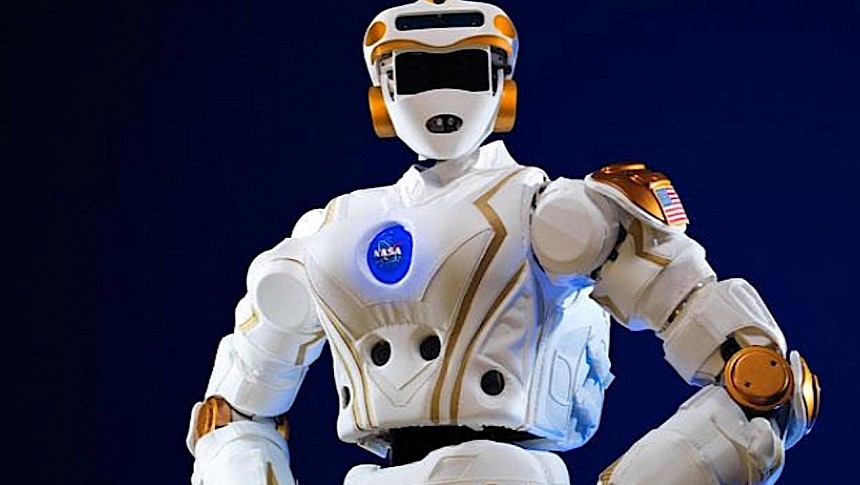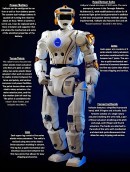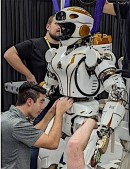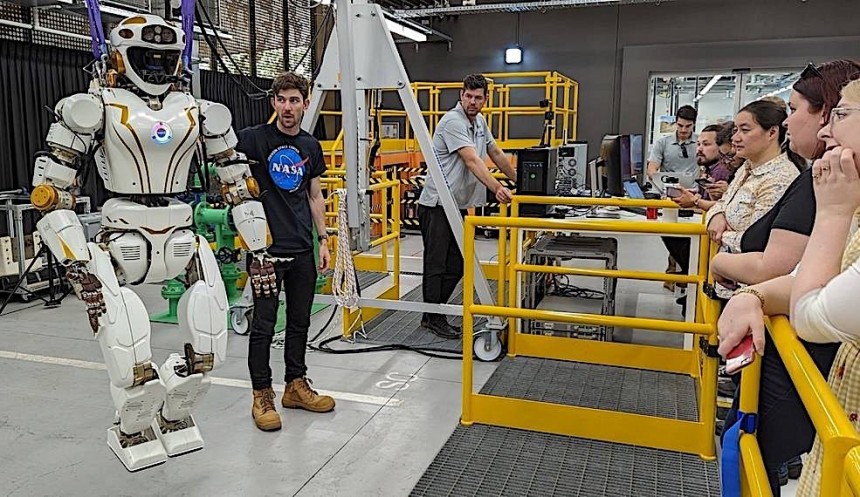There seems to be a trend in the robotics world to make industrial robots shaped like dogs. That's probably because four-legged robots can be more adaptable than bipedal ones, traversing difficult terrain easier. Also, their horizontal bodies also allow for the fitting of more payloads for whatever mission needs to be completed.
Yet when it comes to space exploration, and also to some hazardous activities here on Earth, machines with a tad more dexterity than what robot dogs have are needed. Sure, you could add dexterity to any kind of machine, but nothing beats doing that with a humanoid robot.
Several such contraptions have been designed over the years, but almost all of them turned out to be useless for real-life applications. With the Valkyrie NASA hopes things will be entirely different.
The hardware, officially called R5, dates back to 2013, when it was developed by the agency's Johnson Space Center (JSC) Engineering Directorate for the DARPA Robotics Challenge Trials. It was envisioned as a "robust, rugged, entirely electric humanoid robot capable of operating in degraded or damaged human-engineered environments."
The machine takes a lot after the Robonaut 2, a humanoid torso robot developed together with automotive giant GM that was even flown to the International Space Station (ISS). Other robots made at the JSC also contributed parts and ideas to the Valkyrie, including stuff like electronics, actuators, and sensing tools.
Valkyrie is about as tall as a tall human, measuring 6 feet (1.8 meters). It's a lot heavier though than an average human, tipping the scales at 300 pounds (136 kg). Other than that, it's shaped like each and every one of us, with two legs, two arms, a torso, and a head.
Starting from the ground up, we get legs with five elastic actuators each, allowing for the limbs to move as they would on a human being. The torso is where engineers fitted a number of computer and power pieces of hardware, but also two inertial measurement units.
The thing's arms are moved by means of four actuators and have a total of seven joints. The hand itself comes with three fingers and a thumb. The legs, the arms, and the hands can be removed from the robot to allow for easier shipping.
The head of the robot is where the magic happens. It's there where NASA people installed a perceptual sensor, but also infrared, laser, and camera visualization tools. The robot's brain comes as a pair of Intel Core i7 processors, while its energy needs are handled by means of a 1.8 kWh battery. Optionally, the Valkyrie can draw electricity from a wall.
The robot is still around today, although not much has happened with it in recent years, except for tweaks and improvements performed as a means to get the machine ready for whatever new task NASA envisions for it.
One of the most important improvements made was the inclusion of a walking algorithm supplied by the Florida Institute for Human and Machine Cognition (IHMC). That, together with all the other changes made, will be thoroughly put to the test during the robot's first true mission in years.
NASA announced the robot's newest assignment this week. The Valkyrie will be deployed in Perth, Western Australia, to be tested in facilities of local oil and gas production company Woodside Energy.
The main goal of the deployment is to see if such a robot design could be used to handle remote operations on uncrewed offshore rigs, but whatever the robot will be up to out there could easily be adapted for use in space exploration, and that's exactly what the American space agency is planning to do.
Whatever data Woodside will gather during the robot's mission will be shared with NASA, which will use it to advance its research in robotic helpers for use in space.
The research should deliver some results that could be used as soon as some Artemis Moon exploration missions, because the Valkyrie will probably prove it's ideal for work in the harsh lunar environment.
In the longer run, this robot's descendants could be used for maintenance work on the future habitats humans will most likely build on the surface of the Moon. There are even some ideas to use such humanoid robots for in-situ resource utilization activities.
Naturally, testing could also uncover possible uses of this kind of robots here on Earth, outside the limits of the work the Valkyrie is expected to perform in Australia.
It'll be quite a long time before NASA gets to upgrade the robot in accordance with the findings of its Australian mission, as the Valkyrie's work over at Woodside should not be complete before 2027.
Even so, the development of humanoid robots for real-world applications other than just attending specialized shows is yet another avenue of research through which space exploration can advance greatly. Fingers crossed, then, for the Valkyrie Australian experiment to yield the expected results.
Several such contraptions have been designed over the years, but almost all of them turned out to be useless for real-life applications. With the Valkyrie NASA hopes things will be entirely different.
The hardware, officially called R5, dates back to 2013, when it was developed by the agency's Johnson Space Center (JSC) Engineering Directorate for the DARPA Robotics Challenge Trials. It was envisioned as a "robust, rugged, entirely electric humanoid robot capable of operating in degraded or damaged human-engineered environments."
The machine takes a lot after the Robonaut 2, a humanoid torso robot developed together with automotive giant GM that was even flown to the International Space Station (ISS). Other robots made at the JSC also contributed parts and ideas to the Valkyrie, including stuff like electronics, actuators, and sensing tools.
Valkyrie is about as tall as a tall human, measuring 6 feet (1.8 meters). It's a lot heavier though than an average human, tipping the scales at 300 pounds (136 kg). Other than that, it's shaped like each and every one of us, with two legs, two arms, a torso, and a head.
Starting from the ground up, we get legs with five elastic actuators each, allowing for the limbs to move as they would on a human being. The torso is where engineers fitted a number of computer and power pieces of hardware, but also two inertial measurement units.
The head of the robot is where the magic happens. It's there where NASA people installed a perceptual sensor, but also infrared, laser, and camera visualization tools. The robot's brain comes as a pair of Intel Core i7 processors, while its energy needs are handled by means of a 1.8 kWh battery. Optionally, the Valkyrie can draw electricity from a wall.
The robot is still around today, although not much has happened with it in recent years, except for tweaks and improvements performed as a means to get the machine ready for whatever new task NASA envisions for it.
One of the most important improvements made was the inclusion of a walking algorithm supplied by the Florida Institute for Human and Machine Cognition (IHMC). That, together with all the other changes made, will be thoroughly put to the test during the robot's first true mission in years.
NASA announced the robot's newest assignment this week. The Valkyrie will be deployed in Perth, Western Australia, to be tested in facilities of local oil and gas production company Woodside Energy.
The main goal of the deployment is to see if such a robot design could be used to handle remote operations on uncrewed offshore rigs, but whatever the robot will be up to out there could easily be adapted for use in space exploration, and that's exactly what the American space agency is planning to do.
The research should deliver some results that could be used as soon as some Artemis Moon exploration missions, because the Valkyrie will probably prove it's ideal for work in the harsh lunar environment.
In the longer run, this robot's descendants could be used for maintenance work on the future habitats humans will most likely build on the surface of the Moon. There are even some ideas to use such humanoid robots for in-situ resource utilization activities.
Naturally, testing could also uncover possible uses of this kind of robots here on Earth, outside the limits of the work the Valkyrie is expected to perform in Australia.
It'll be quite a long time before NASA gets to upgrade the robot in accordance with the findings of its Australian mission, as the Valkyrie's work over at Woodside should not be complete before 2027.
Even so, the development of humanoid robots for real-world applications other than just attending specialized shows is yet another avenue of research through which space exploration can advance greatly. Fingers crossed, then, for the Valkyrie Australian experiment to yield the expected results.








